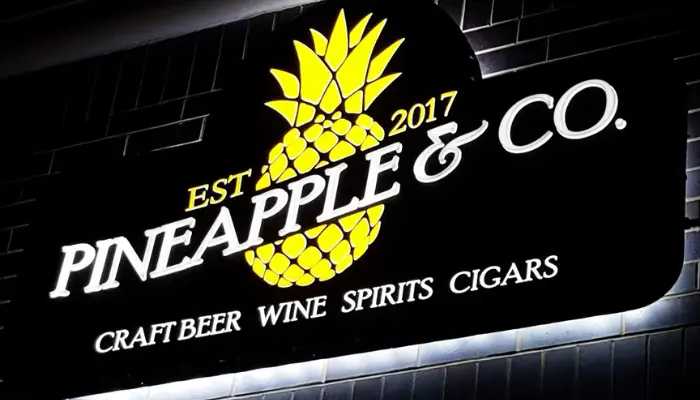Best Custom Sign Making Company in Chicago
Tired of blending in? Make your business or shop stand out with Signs House!
We craft eye-catching, custom outdoor signs that stop traffic and turn heads. Forget generic templates. We collaborate with you to design unique signage that perfectly reflects your brand and attracts your ideal customers.
Storefront Signs, Channel Letters, and all Types of Signs
Top Custom Business Outdoor Signs We Make
Need Custom Signage? Signs House GOT THE KNOW HOW!
Our Storefront signs draw the eye’s attention to your business.
Signs House provides a complete sign service from concept and design to manufacturing, installation, and maintenance that will take your brand to the next level.
Channel Letter Signs
Dazzle day & night with illuminated letters & logos. Bold, custom designs that project your brand high & bright. Stand out from the crowd, attract attention, & get noticed!
Store-front Signs
Make a powerful first impression. Custom-designed signs that reflect your brand & grab attention. Boost foot traffic, brand awareness, & sales with eye-catching solutions.
Monument Signs
Create a lasting impression with grand, ground-level signage. Elegant & impactful, perfect for building entrances, corporate campuses, & high-visibility locations. Make a statement & solidify your presence.
Cabinet/light box sign
Illuminate your message with vibrant, energy-efficient displays. Versatile & eye-catching, perfect for promotions, menus, & 24/7 brand visibility. Update easily & keep your message fresh!
Our Custom Sings Making Process
Making custom sings for your business outdoor is a very detail-sensitive process and requires an experienced team to handle different stages from concept and design to fabrication and installation.
Concept
This step is done by a consultant that will offer the best options for your project.
Design
A professional industrial designer will work on your options to make your brand hot!
Permit process
Once designs approved, we then take care of your paperwork and arrangement with the city to ensure smoothness to the process.
Fabrication / Manufacturing
With the best technologies in the trade, you will get the product that will add a lot to your brand!
Installation
A professional installation crew is always there to meet your deadline and save the day.
Maintainance
We are proud of our signs, and we will always take care of them, 2-year warranty on our signs will give you peace of mind.

Why Choose Signs House?
Want your business brand to stand out? Whether you need illuminated channel letters, bold vinyl banners, storefrong signs, or stunning digital displays, our expert team brings your vision to life with high-quality materials and craftsmanship. We go beyond just signs – we deliver increased brand awareness, boosted foot traffic, and measurable results.
At Signs House, we specialize in creating high-quality custom signs tailored to meet the unique needs of businesses in Chicago and the surrounding areas. From eye-catching outdoor signs to stylish exterior signage, we are your trusted partner in making your business stand out.
Start your project here
Why We Are Best Sign Making Shop in Chicago?
Expert Custom Business Outdoor Sign Craftsmanship
Our team of skilled artisans combines creativity and precision to craft signs that make a lasting impression. With years of experience, we understand the importance of a well-designed sign in attracting customers and enhancing your brand visibility.
Local Signs Expertise
As a local sign company in Chicago, we take pride in understanding the unique needs of businesses in our community. We are committed to delivering signage solutions that not only meet but exceed your expectations.
Wide Range of Options
Explore our diverse range of sign options, including outdoor signs for business, exterior signs, custom sign designs, and more. Whatever your business needs, Signs House has the perfect signage solution for you.


OUR LATEST NEWS
Come on In!
Weekdays
8AM -8PM
Weekends
10AM – 6 pM
Phone
Address
3415 N Pulaski Rd, Chicago, IL 60641
Full Service Storefront Signs Company
At Signs House, we understand the customers needs, and how time is your valuble source, we will take of your whole project and save you the time for all the proccess, we will start with provideing the options that best fit your location, and come up with the best design that will give you the best visibility and the brand image that your customer will admire, and then we will fabricate your sign profissionaly and install it then let you admire the final product for years to com.
More Signage Options
-
A-frame Signs
-
ADA Signs
-
Acrylic Signs
-
Address Signs
-
Awning Signs
-
Banners
-
Bar Signs
-
Blade Signs
-
Boat Wraps
-
Building Signs
-
Bus Wraps
-
Cabinet Signs
-
Canopy Tents
-
Car Wraps
-
Channel Letters
-
Church Signs
-
Construction Signs
-
Custom Table Covers
-
Decals
-
Digital Signs
-
Dimensional Letters
-
Door Signs
-
Electronic Signs
-
Flag Signs
-
Fleet Wraps
-
Floor Signs
-
Gas Station Signs
-
Hanging Signs
-
Informational Signs
-
LED Signs
-
Large Banners
-
Lighted Signs
-
Lobby Signs
-
Menu Boards
-
Metal Signs
-
Monument Signs
-
Office Signs
-
POP Signs
-
Pole Signs
-
Portable Signs
-
Post & Panel Signs
-
Printed Backdrops
-
Product Displays
-
Promotional Signs
-
Pylon Signs
-
Real Estate Signs
-
Restaurant Signs
-
Retail Signs
-
Retractable Banners
-
Room ID Signs
-
Safety Signs
-
Sandblasted Signs
-
School Signs
-
Sidewalk Signs
-
Storefront Signs
-
Table Top Displays
-
Temporary Signs
-
Tenant Signs
-
Trade Show Displays
-
Trade Show Booths
-
Trade Show Exhibits
-
Trailer Wraps
-
Truck Wraps
-
Van Wraps
-
Vehicle Decals
-
Vehicle Graphics
-
Vehicle Lettering
-
Vehicle Magnets
-
Vehicle Window Film
-
Vinyl Lettering
-
Vinyl Printing
-
Vinyl Wraps
-
Wall Graphics
-
Wall Murals
-
Wall Signs
-
Warehouse Signs
-
Wayfinding Signs
-
Window Film
-
Window Graphics
-
Window Signs
-
Yard Signs
Locations we Serve
Addison Sign Company
Bartlett Sign Company
Bensenville Sign Company
Berkeley Sign Company
Bloomingdale Sign Company
Carol Stream Sign Company
Chicago Sign Company
Chicagoland Sign Company
Des Plaines Sign Company
Dundee Sign Company
East Dundee Sign Company
Elgin Sign Company
Elk Grove Village Sign Company
Elmhurst Sign Company
Fox Valley Sign Company
Franklin Park Sign Company
Geneva Sign Company
Gilberts Sign Company
Glen Ellyn Sign Company
Glendale Heights Sign Company
Hampshire Sign Company
Hanover Park Sign Company
Hoffman Estates Sign Company
Itasca Sign Company
Lombard Sign Company
Medinah Sign Company
Melrose Park Sign Company
Northlake Sign Company
Roselle Sign Company
Saint Charles Sign Company
Schaumburg Sign Company
South Elgin Sign Company
Streamwood Sign Company
Villa Park Sign Company
Wayne Sign Company
West Chicago Sign Company
West Dundee Sign Company
Winfield Sign Company
Wood Dale Sign Company
Addison Indoor Signs
Bartlett Indoor Signs
Bensenville Indoor Signs
Berkeley Indoor Signs
Bloomingdale Indoor Signs
Carol Stream Indoor Signs
Chicago Indoor Signs
Chicagoland Indoor Signs
Des Plaines Indoor Signs
Dundee Indoor Signs
East Dundee Indoor Signs
Elgin Indoor Signs
Elk Grove Village Indoor Signs
Elmhurst Indoor Signs
Fox Valley Indoor Signs
Franklin Park Indoor Signs
Geneva Indoor Signs
Gilberts Indoor Signs
Glen Ellyn Indoor Signs
Glendale Heights Indoor Signs
Hampshire Indoor Signs
Hanover Park Indoor Signs
Hoffman Estates Indoor Signs
Itasca Indoor Signs
Lombard Indoor Signs
Medinah Indoor Signs
Melrose Park Indoor Signs
Northlake Indoor Signs
Roselle Indoor Signs
Saint Charles Indoor Signs
Schaumburg Indoor Signs
South Elgin Indoor Signs
Streamwood Indoor Signs
Villa Park Indoor Signs
Wayne Indoor Signs
West Chicago Indoor Signs
West Dundee Indoor Signs
Winfield Indoor Signs
Wood Dale Indoor Signs
Addison Outdoor Signs
Bartlett Outdoor Signs
Bensenville Outdoor Signs
Berkeley Outdoor Signs
Bloomingdale Outdoor Signs
Carol Stream Outdoor Signs
Chicago Outdoor Signs
Chicagoland Outdoor Signs
Des Plaines Outdoor Signs
Dundee Outdoor Signs
East Dundee Outdoor Signs
Elgin Outdoor Signs
Elk Grove Village Outdoor Signs
Elmhurst Outdoor Signs
Fox Valley Outdoor Signs
Franklin Park Outdoor Signs
Geneva Outdoor Signs
Gilberts Outdoor Signs
Glen Ellyn Outdoor Signs
Glendale Heights Outdoor Signs
Hampshire Outdoor Signs
Hanover Park Outdoor Signs
Hoffman Estates Outdoor Signs
Itasca Outdoor Signs
Lombard Outdoor Signs
Medinah Outdoor Signs
Melrose Park Outdoor Signs
Northlake Outdoor Signs
Roselle Outdoor Signs
Saint Charles Outdoor Signs
Schaumburg Outdoor Signs
South Elgin Outdoor Signs
Streamwood Outdoor Signs
Villa Park Outdoor Signs
Wayne Outdoor Signs
West Chicago Outdoor Signs
West Dundee Outdoor Signs
Winfield Outdoor Signs
Wood Dale Outdoor Signs
Addison Vinyl Lettering
Bartlett Vinyl Lettering
Bensenville Vinyl Lettering
Berkeley Vinyl Lettering
Bloomingdale Vinyl Lettering
Carol Stream Vinyl Lettering
Chicago Vinyl Lettering
Chicagoland Vinyl Lettering
Des Plaines Vinyl Lettering
Dundee Vinyl Lettering
East Dundee Vinyl Lettering
Elgin Vinyl Lettering
Elk Grove Village Vinyl Lettering
Elmhurst Vinyl Lettering
Fox Valley Vinyl Lettering
Franklin Park Vinyl Lettering
Geneva Vinyl Lettering
Gilberts Vinyl Lettering
Glen Ellyn Vinyl Lettering
Glendale Heights Vinyl Lettering
Hampshire Vinyl Lettering
Hanover Park Vinyl Lettering
Hoffman Estates Vinyl Lettering
Itasca Vinyl Lettering
Lombard Vinyl Lettering
Medinah Vinyl Lettering
Melrose Park Vinyl Lettering
Northlake Vinyl Lettering
Roselle Vinyl Lettering
Saint Charles Vinyl Lettering
Schaumburg Vinyl Lettering
South Elgin Vinyl Lettering
Streamwood Vinyl Lettering
Villa Park Vinyl Lettering
Wayne Vinyl Lettering
West Chicago Vinyl Lettering
West Dundee Vinyl Lettering
Winfield Vinyl Lettering
Wood Dale Vinyl Lettering
Addison Vinyl Signs
Bartlett Vinyl Signs
Bensenville Vinyl Signs
Berkeley Vinyl Signs
Bloomingdale Vinyl Signs
Carol Stream Vinyl Signs
Chicago Vinyl Signs
Chicagoland Vinyl Signs
Des Plaines Vinyl Signs
Dundee Vinyl Signs
East Dundee Vinyl Signs
Elgin Vinyl Signs
Elk Grove Village Vinyl Signs
Elmhurst Vinyl Signs
Fox Valley Vinyl Signs
Franklin Park Vinyl Signs
Geneva Vinyl Signs
Gilberts Vinyl Signs
Glen Ellyn Vinyl Signs
Glendale Heights Vinyl Signs
Hampshire Vinyl Signs
Hanover Park Vinyl Signs
Hoffman Estates Vinyl Signs
Itasca Vinyl Signs
Lombard Vinyl Signs
Medinah Vinyl Signs
Melrose Park Vinyl Signs
Northlake Vinyl Signs
Roselle Vinyl Signs
Saint Charles Vinyl Signs
Schaumburg Vinyl Signs
South Elgin Vinyl Signs
Streamwood Vinyl Signs
Villa Park Vinyl Signs
Wayne Vinyl Signs
West Chicago Vinyl Signs
West Dundee Vinyl Signs
Winfield Vinyl Signs
Wood Dale Vinyl Signs
Addison Vehicle Wraps
Bartlett Vehicle Wraps
Bensenville Vehicle Wraps
Berkeley Vehicle Wraps
Bloomingdale Vehicle Wraps
Carol Stream Vehicle Wraps
Chicago Vehicle Wraps
Chicagoland Vehicle Wraps
Des Plaines Vehicle Wraps
Dundee Vehicle Wraps
East Dundee Vehicle Wraps
Elgin Vehicle Wraps
Elk Grove Village Vehicle Wraps
Elmhurst Vehicle Wraps
Fox Valley Vehicle Wraps
Franklin Park Vehicle Wraps
Geneva Vehicle Wraps
Gilberts Vehicle Wraps
Glen Ellyn Vehicle Wraps
Glendale Heights Vehicle Wraps
Hampshire Vehicle Wraps
Hanover Park Vehicle Wraps
Hoffman Estates Vehicle Wraps
Itasca Vehicle Wraps
Lombard Vehicle Wraps
Medinah Vehicle Wraps
Melrose Park Vehicle Wraps
Northlake Vehicle Wraps
Roselle Vehicle Wraps
Saint Charles Vehicle Wraps
Schaumburg Vehicle Wraps
South Elgin Vehicle Wraps
Streamwood Vehicle Wraps
Villa Park Vehicle Wraps
Wayne Vehicle Wraps
West Chicago Vehicle Wraps
West Dundee Vehicle Wraps
Winfield Vehicle Wraps
Wood Dale Vehicle Wraps
Addison Vinyl Wraps
Bartlett Vinyl Wraps
Bensenville Vinyl Wraps
Berkeley Vinyl Wraps
Bloomingdale Vinyl Wraps
Carol Stream Vinyl Wraps
Chicago Vinyl Wraps
Chicagoland Vinyl Wraps
Des Plaines Vinyl Wraps
Dundee Vinyl Wraps
East Dundee Vinyl Wraps
Elgin Vinyl Wraps
Elk Grove Village Vinyl Wraps
Elmhurst Vinyl Wraps
Fox Valley Vinyl Wraps
Franklin Park Vinyl Wraps
Geneva Vinyl Wraps
Gilberts Vinyl Wraps
Glen Ellyn Vinyl Wraps
Glendale Heights Vinyl Wraps
Hampshire Vinyl Wraps
Hanover Park Vinyl Wraps
Hoffman Estates Vinyl Wraps
Itasca Vinyl Wraps
Lombard Vinyl Wraps
Medinah Vinyl Wraps
Melrose Park Vinyl Wraps
Northlake Vinyl Wraps
Roselle Vinyl Wraps
Saint Charles Vinyl Wraps
Schaumburg Vinyl Wraps
South Elgin Vinyl Wraps
Streamwood Vinyl Wraps
Villa Park Vinyl Wraps
Wayne Vinyl Wraps
West Chicago Vinyl Wraps
West Dundee Vinyl Wraps
Winfield Vinyl Wraps
Wood Dale Vinyl Wraps
Addison Window Graphics
Bartlett Window Graphics
Bensenville Window Graphics
Berkeley Window Graphics
Bloomingdale Window Graphics
Carol Stream Window Graphics
Chicago Window Graphics
Chicagoland Window Graphics
Des Plaines Window Graphics
Dundee Window Graphics
East Dundee Window Graphics
Elgin Window Graphics
Elk Grove Village Window Graphics
Elmhurst Window Graphics
Fox Valley Window Graphics
Franklin Park Window Graphics
Geneva Window Graphics
Gilberts Window Graphics
Glen Ellyn Window Graphics
Glendale Heights Window Graphics
Hampshire Window Graphics
Hanover Park Window Graphics
Hoffman Estates Window Graphics
Itasca Window Graphics
Lombard Window Graphics
Medinah Window Graphics
Melrose Park Window Graphics
Northlake Window Graphics
Roselle Window Graphics
Saint Charles Window Graphics
Schaumburg Window Graphics
South Elgin Window Graphics
Streamwood Window Graphics
Villa Park Window Graphics
Wayne Window Graphics
West Chicago Window Graphics
West Dundee Window Graphics
Winfield Window Graphics
Wood Dale Window Graphics
Addison Business Signs
Bartlett Business Signs
Bensenville Business Signs
Berkeley Business Signs
Bloomingdale Business Signs
Carol Stream Business Signs
Chicago Business Signs
Chicagoland Business Signs
Des Plaines Business Signs
Dundee Business Signs
East Dundee Business Signs
Elgin Business Signs
Elk Grove Village Business Signs
Elmhurst Business Signs
Fox Valley Business Signs
Franklin Park Business Signs
Geneva Business Signs
Gilberts Business Signs
Glen Ellyn Business Signs
Glendale Heights Business Signs
Hampshire Business Signs
Hanover Park Business Signs
Hoffman Estates Business Signs
Itasca Business Signs
Lombard Business Signs
Medinah Business Signs
Melrose Park Business Signs
Northlake Business Signs
Roselle Business Signs
Saint Charles Business Signs
Schaumburg Business Signs
South Elgin Business Signs
Streamwood Business Signs
Villa Park Business Signs
Wayne Business Signs
West Chicago Business Signs
West Dundee Business Signs
Winfield Business Signs
Wood Dale Business Signs
Addison Post & Panel Signs
Bartlett Post & Panel Signs
Bensenville Post & Panel Signs
Berkeley Post & Panel Signs
Bloomingdale Post & Panel Signs
Carol Stream Post & Panel Signs
Chicago Post & Panel Signs
Chicagoland Post & Panel Signs
Des Plaines Post & Panel Signs
Dundee Post & Panel Signs
East Dundee Post & Panel Signs
Elgin Post & Panel Signs
Elk Grove Village Post & Panel Signs
Elmhurst Post & Panel Signs
Fox Valley Post & Panel Signs
Franklin Park Post & Panel Signs
Geneva Post & Panel Signs
Gilberts Post & Panel Signs
Glen Ellyn Post & Panel Signs
Glendale Heights Post & Panel Signs
Hampshire Post & Panel Signs
Hanover Park Post & Panel Signs
Hoffman Estates Post & Panel Signs
Itasca Post & Panel Signs
Lombard Post & Panel Signs
Medinah Post & Panel Signs
Melrose Park Post & Panel Signs
Northlake Post & Panel Signs
Roselle Post & Panel Signs
Saint Charles Post & Panel Signs
Schaumburg Post & Panel Signs
South Elgin Post & Panel Signs
Streamwood Post & Panel Signs
Villa Park Post & Panel Signs
Wayne Post & Panel Signs
West Chicago Post & Panel Signs
West Dundee Post & Panel Signs
Winfield Post & Panel Signs
Wood Dale Post & Panel Signs
Addison Window Signs
Bartlett Window Signs
Bensenville Window Signs
Berkeley Window Signs
Bloomingdale Window Signs
Carol Stream Window Signs
Chicago Window Signs
Chicagoland Window Signs
Des Plaines Window Signs
Dundee Window Signs
East Dundee Window Signs
Elgin Window Signs
Elk Grove Village Window Signs
Elmhurst Window Signs
Fox Valley Window Signs
Franklin Park Window Signs
Geneva Window Signs
Gilberts Window Signs
Glen Ellyn Window Signs
Glendale Heights Window Signs
Hampshire Window Signs
Hanover Park Window Signs
Hoffman Estates Window Signs
Itasca Window Signs
Lombard Window Signs
Medinah Window Signs
Melrose Park Window Signs
Northlake Window Signs
Roselle Window Signs
Saint Charles Window Signs
Schaumburg Window Signs
South Elgin Window Signs
Streamwood Window Signs
Villa Park Window Signs
Wayne Window Signs
West Chicago Window Signs
West Dundee Window Signs
Winfield Window Signs
Wood Dale Window Signs
Addison Wall Graphics
Bartlett Wall Graphics
Bensenville Wall Graphics
Berkeley Wall Graphics
Bloomingdale Wall Graphics
Carol Stream Wall Graphics
Chicago Wall Graphics
Chicagoland Wall Graphics
Des Plaines Wall Graphics
Dundee Wall Graphics
East Dundee Wall Graphics
Elgin Wall Graphics
Elk Grove Village Wall Graphics
Elmhurst Wall Graphics
Fox Valley Wall Graphics
Franklin Park Wall Graphics
Geneva Wall Graphics
Gilberts Wall Graphics
Glen Ellyn Wall Graphics
Glendale Heights Wall Graphics
Hampshire Wall Graphics
Hanover Park Wall Graphics
Hoffman Estates Wall Graphics
Itasca Wall Graphics
Lombard Wall Graphics
Medinah Wall Graphics
Melrose Park Wall Graphics
Northlake Wall Graphics
Roselle Wall Graphics
Saint Charles Wall Graphics
Schaumburg Wall Graphics
South Elgin Wall Graphics
Streamwood Wall Graphics
Villa Park Wall Graphics
Wayne Wall Graphics
West Chicago Wall Graphics
West Dundee Wall Graphics
Winfield Wall Graphics
Wood Dale Wall Graphics
Addison Custom Signs
Bartlett Custom Signs
Bensenville Custom Signs
Berkeley Custom Signs
Bloomingdale Custom Signs
Carol Stream Custom Signs
Chicago Custom Signs
Chicagoland Custom Signs
Des Plaines Custom Signs
Dundee Custom Signs
East Dundee Custom Signs
Elgin Custom Signs
Elk Grove Village Custom Signs
Elmhurst Custom Signs
Fox Valley Custom Signs
Franklin Park Custom Signs
Geneva Custom Signs
Gilberts Custom Signs
Glen Ellyn Custom Signs
Glendale Heights Custom Signs
Hampshire Custom Signs
Hanover Park Custom Signs
Hoffman Estates Custom Signs
Itasca Custom Signs
Lombard Custom Signs
Medinah Custom Signs
Melrose Park Custom Signs
Northlake Custom Signs
Roselle Custom Signs
Saint Charles Custom Signs
Schaumburg Custom Signs
South Elgin Custom Signs
Streamwood Custom Signs
Villa Park Custom Signs
Wayne Custom Signs
West Chicago Custom Signs
West Dundee Custom Signs
Winfield Custom Signs
Wood Dale Custom Signs
Addison Dimensional Letters
Bartlett Dimensional Letters
Bensenville Dimensional Letters
Berkeley Dimensional Letters
Bloomingdale Dimensional Letters
Carol Stream Dimensional Letters
Chicago Dimensional Letters
Chicagoland Dimensional Letters
Des Plaines Dimensional Letters
Dundee Dimensional Letters
East Dundee Dimensional Letters
Elgin Dimensional Letters
Elk Grove Village Dimensional Letters
Elmhurst Dimensional Letters
Fox Valley Dimensional Letters
Franklin Park Dimensional Letters
Geneva Dimensional Letters
Gilberts Dimensional Letters
Glen Ellyn Dimensional Letters
Glendale Heights Dimensional Letters
Hampshire Dimensional Letters
Hanover Park Dimensional Letters
Hoffman Estates Dimensional Letters
Itasca Dimensional Letters
Lombard Dimensional Letters
Medinah Dimensional Letters
Melrose Park Dimensional Letters
Northlake Dimensional Letters
Roselle Dimensional Letters
Saint Charles Dimensional Letters
Schaumburg Dimensional Letters
South Elgin Dimensional Letters
Streamwood Dimensional Letters
Villa Park Dimensional Letters
Wayne Dimensional Letters
West Chicago Dimensional Letters
West Dundee Dimensional Letters
Winfield Dimensional Letters
Wood Dale Dimensional Letters
Addison Wall Murals
Bartlett Wall Murals
Bensenville Wall Murals
Berkeley Wall Murals
Bloomingdale Wall Murals
Carol Stream Wall Murals
Chicago Wall Murals
Chicagoland Wall Murals
Des Plaines Wall Murals
Dundee Wall Murals
East Dundee Wall Murals
Elgin Wall Murals
Elk Grove Village Wall Murals
Elmhurst Wall Murals
Fox Valley Wall Murals
Franklin Park Wall Murals
Geneva Wall Murals
Gilberts Wall Murals
Glen Ellyn Wall Murals
Glendale Heights Wall Murals
Hampshire Wall Murals
Hanover Park Wall Murals
Hoffman Estates Wall Murals
Itasca Wall Murals
Lombard Wall Murals
Medinah Wall Murals
Melrose Park Wall Murals
Northlake Wall Murals
Roselle Wall Murals
Saint Charles Wall Murals
Schaumburg Wall Murals
South Elgin Wall Murals
Streamwood Wall Murals
Villa Park Wall Murals
Wayne Wall Murals
West Chicago Wall Murals
West Dundee Wall Murals
Winfield Wall Murals
Wood Dale Wall Murals
Addison Vinyl Printing
Bartlett Vinyl Printing
Bensenville Vinyl Printing
Berkeley Vinyl Printing
Bloomingdale Vinyl Printing
Carol Stream Vinyl Printing
Chicago Vinyl Printing
Chicagoland Vinyl Printing
Des Plaines Vinyl Printing
Dundee Vinyl Printing
East Dundee Vinyl Printing
Elgin Vinyl Printing
Elk Grove Village Vinyl Printing
Elmhurst Vinyl Printing
Fox Valley Vinyl Printing
Franklin Park Vinyl Printing
Geneva Vinyl Printing
Gilberts Vinyl Printing
Glen Ellyn Vinyl Printing
Glendale Heights Vinyl Printing
Hampshire Vinyl Printing
Hanover Park Vinyl Printing
Hoffman Estates Vinyl Printing
Itasca Vinyl Printing
Lombard Vinyl Printing
Medinah Vinyl Printing
Melrose Park Vinyl Printing
Northlake Vinyl Printing
Roselle Vinyl Printing
Saint Charles Vinyl Printing
Schaumburg Vinyl Printing
South Elgin Vinyl Printing
Streamwood Vinyl Printing
Villa Park Vinyl Printing
Wayne Vinyl Printing
West Chicago Vinyl Printing
West Dundee Vinyl Printing
Winfield Vinyl Printing
Wood Dale Vinyl Printing




